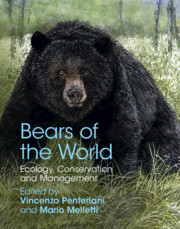Book contents
- Bears of the World
- Bears of the World
- Copyright page
- Dedication
- Frontispiece
- Contents
- Contributors
- Foreword
- Acknowledgments
- Introduction
- Part I Systematics, Ecology, and Behavior
- Chapter 1 Systematics, Evolution, and Genetics of Bears
- Chapter 2 Mating Strategies
- Chapter 3 Interspecific Interactions between Brown Bears, Ungulates, and Other Large Carnivores
- Chapter 4 Adaptations and Competitive Interactions of Tropical Asian Bear Species Define Their Biogeography: Past, Present, and Future
- Chapter 5 Remarkable Adaptations of the American Black Bear Help Explain Why it is the Most Common Bear: A Long-Term Study from the Center of its Range
- Part II Species Accounts
- Part III Human–Bear Coexistence
- Part IV Conservation and ManagementConservation and Management
- Index
- Miscellaneous Endmatter
- Plate Section (PDF Only)
- References
Chapter 1 - Systematics, Evolution, and Genetics of Bears
from Part I - Systematics, Ecology, and Behavior
Published online by Cambridge University Press: 16 November 2020
- Bears of the World
- Bears of the World
- Copyright page
- Dedication
- Frontispiece
- Contents
- Contributors
- Foreword
- Acknowledgments
- Introduction
- Part I Systematics, Ecology, and Behavior
- Chapter 1 Systematics, Evolution, and Genetics of Bears
- Chapter 2 Mating Strategies
- Chapter 3 Interspecific Interactions between Brown Bears, Ungulates, and Other Large Carnivores
- Chapter 4 Adaptations and Competitive Interactions of Tropical Asian Bear Species Define Their Biogeography: Past, Present, and Future
- Chapter 5 Remarkable Adaptations of the American Black Bear Help Explain Why it is the Most Common Bear: A Long-Term Study from the Center of its Range
- Part II Species Accounts
- Part III Human–Bear Coexistence
- Part IV Conservation and ManagementConservation and Management
- Index
- Miscellaneous Endmatter
- Plate Section (PDF Only)
- References
Summary
Molecular genetics are key to understanding current and historical relationships between isolated populations, including species’ colonizations during glacial–interglacial cycles, to determine viability of local populations, needs for habitat corridors, and other aspects of population management, especially where bears are harvested for sport, etc. As natural habitats shrink, some bear species will inevitably require high levels of management, perhaps combining captive and wild populations following the IUCN’s One Plan Approach. In this chapter we review the systematics of the Ursidae and its relationships with other Carnivora, the molecular phylogenetic of extant ursid species, the phylogeography of and morphological variation within each species, and the use of molecular genetics to monitor bear populations for management and conservation.
- Type
- Chapter
- Information
- Bears of the WorldEcology, Conservation and Management, pp. 3 - 20Publisher: Cambridge University PressPrint publication year: 2020
References
- 2
- Cited by

